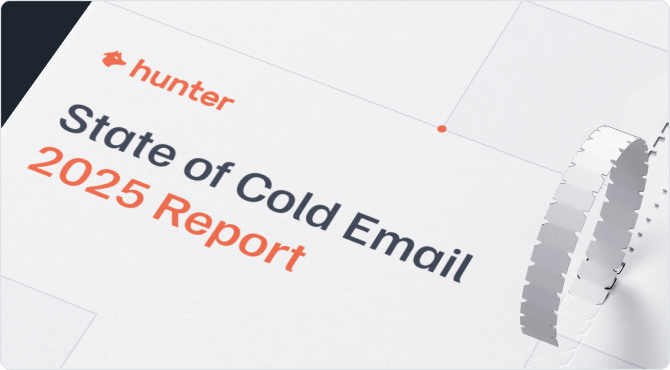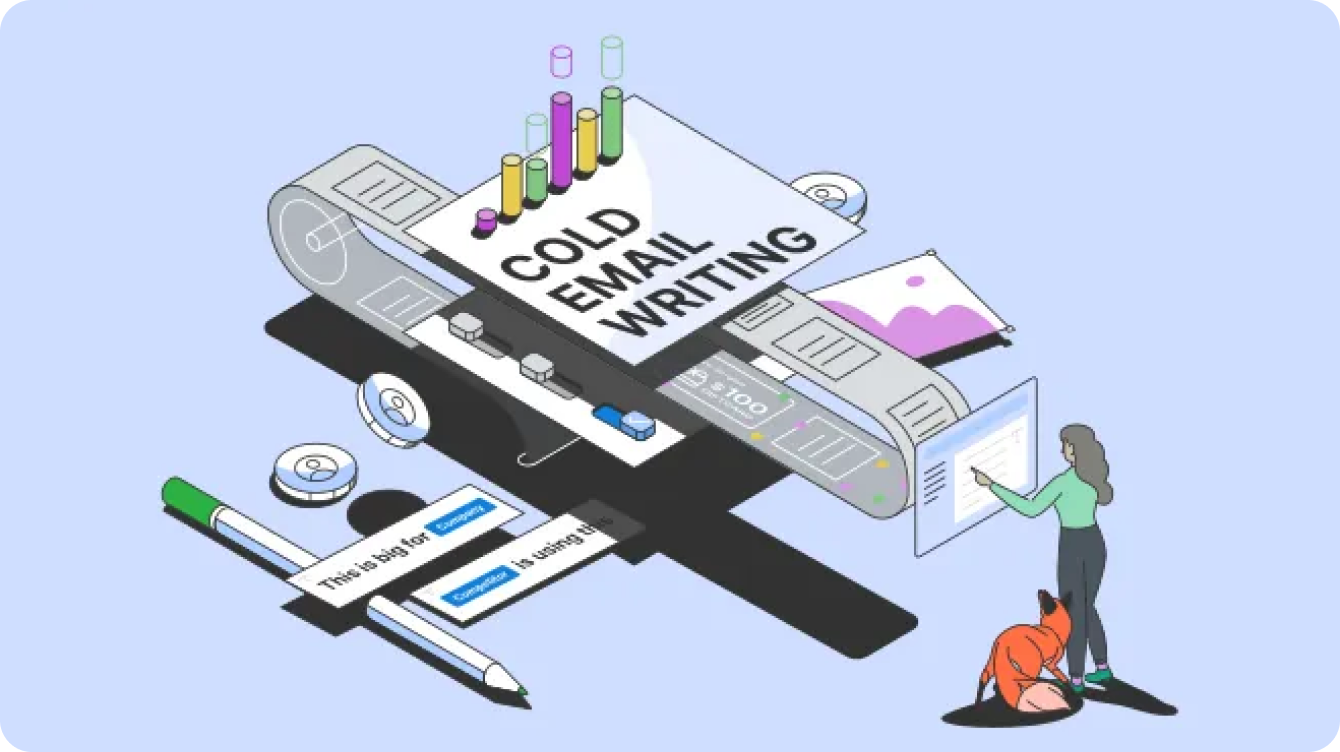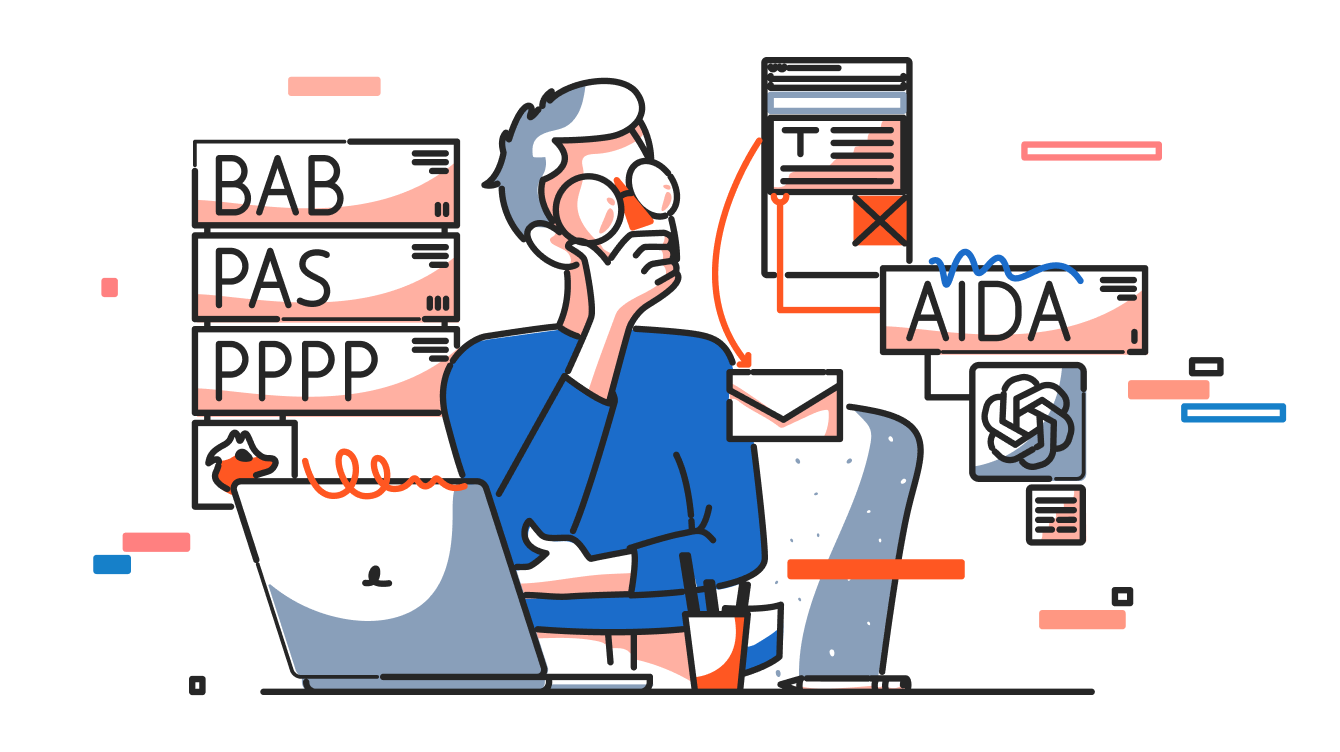Looking back
Back in 2022, we sent out a survey to our users because we wanted to learn from them.
We were interested in what they think is the best way to succeed with cold email based on their own experience.
We learned that no matter your specific use case, researching your prospects and using what you learned to personalize your emails is the key. It's what differentiates cold email from spam.
At Hunter, we've always believed that successful outreach prioritizes quality over quantity, and cold email will always have its place in business as long as it remains focused on building personal connections through relevance and trust.
In 2022, 54.4% of survey respondents stated that cold email outreach was getting harder.
But the world has changed since 2022, and so has cold email—even if the core principles remain.
We've seen an explosion of tools and automations (including AI), lowering the barrier to entry. To the 72.9% of survey respondents who spent 1 to 10 hours every month managing cold email campaigns, this has drastically cut down time and been a positive.
For the average recipient, this hasn't been positive.
Just as our personal data is increasingly at risk and every decision-maker is bombarded with proposals, we've grown desensitized to outreach flooding our mailboxes, and email providers introduced stricter spam filters to protect users.
Mindful of these shifts, we wanted to take a different research approach to see if our assumptions about the state of email outreach are true.
TL;DR
Relevance and trustworthiness are the factors determining email outreach success in 2025. Our State of Cold Email 2025 research shows why.
By surveying 217 decision-makers and analyzing a staggering 11 million cold emails sent in 2024, we've pinpointed what makes a cold email work.
Here's our TL;DR breakdown:

Outreach preferences
Outreach takes many forms, but in 2025 the three channels that are predominantly used to reach prospects are cold email, cold call, and LinkedIn.
We asked decision-makers about their preferred channel, and 61% chose cold email, leaving LinkedIn (29%) and cold call (10%) far behind.
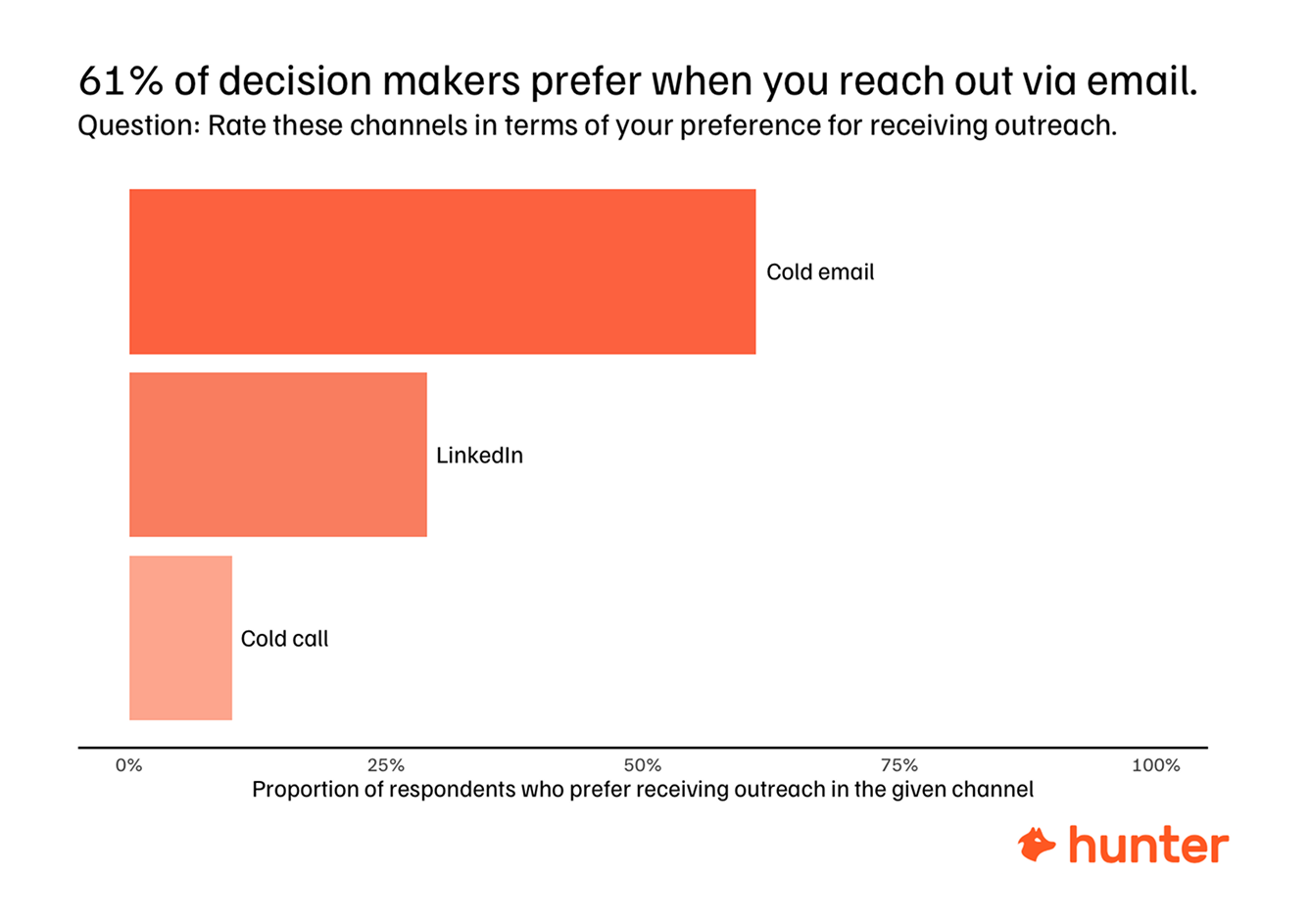
Looking at just US-based decision-makers, the preference for cold emails increases to 71%.
Even though decision-makers prefer cold emails, the average reply rate to a campaign is 4.1%. That means 95.9% of cold emails go unanswered.

Before we explore the factors associated with higher reply rates, let's consider how cold email shapes the day-to-day lives of decision-makers.
They receive a significant volume of cold emails every week.
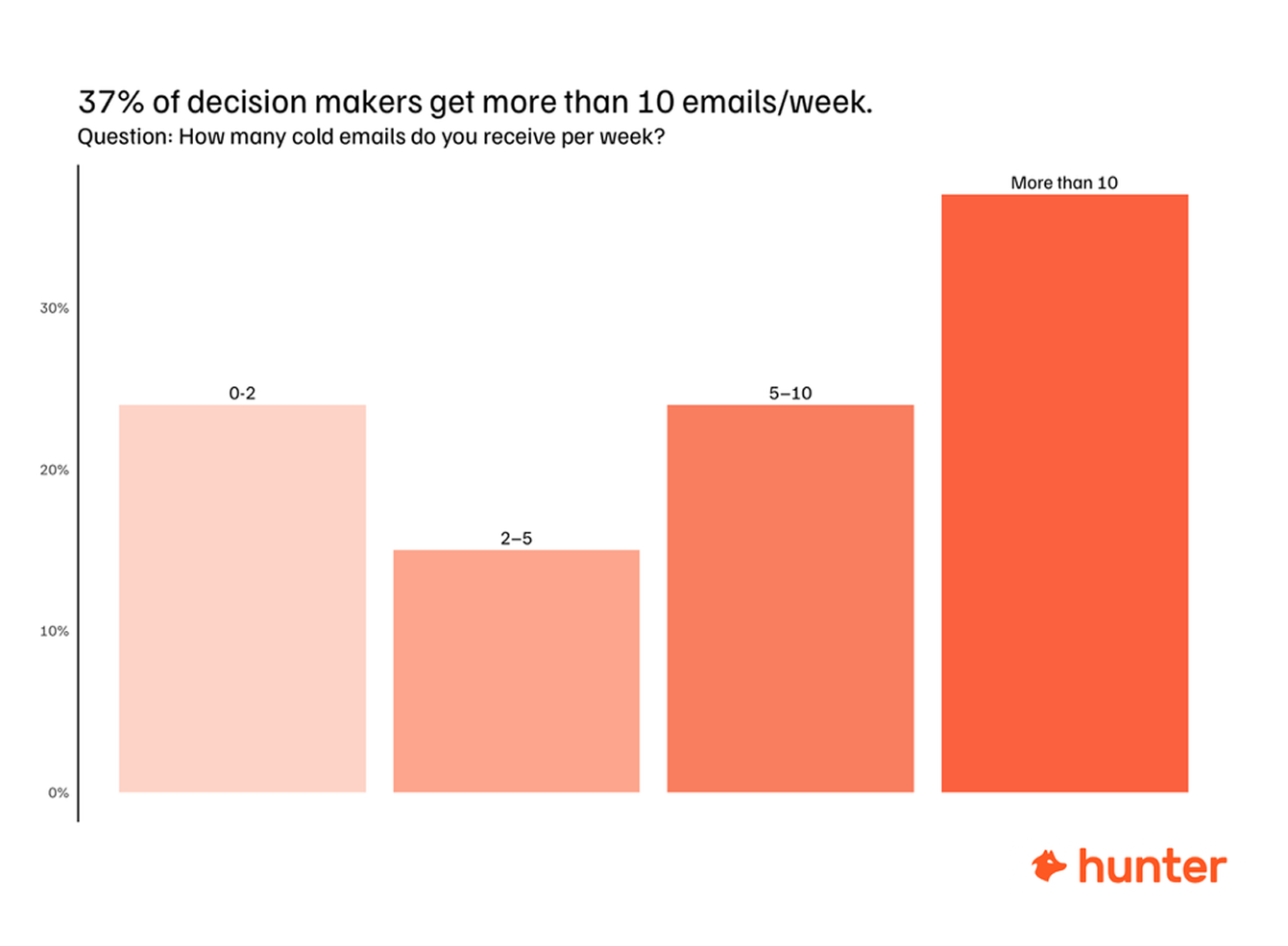
However, most of these cold emails don't meet their expectations.

Only 24% say they receive a valuable email at least once a week.
20% claim they never receive relevant emails.
This shows that a large portion of email outreach is effectively spam–unwanted mail that decision-makers receive in great quantity.
We suspected something like this, which is why we asked decision-makers why they don't respond. Relevance is the biggest issue by a long way:
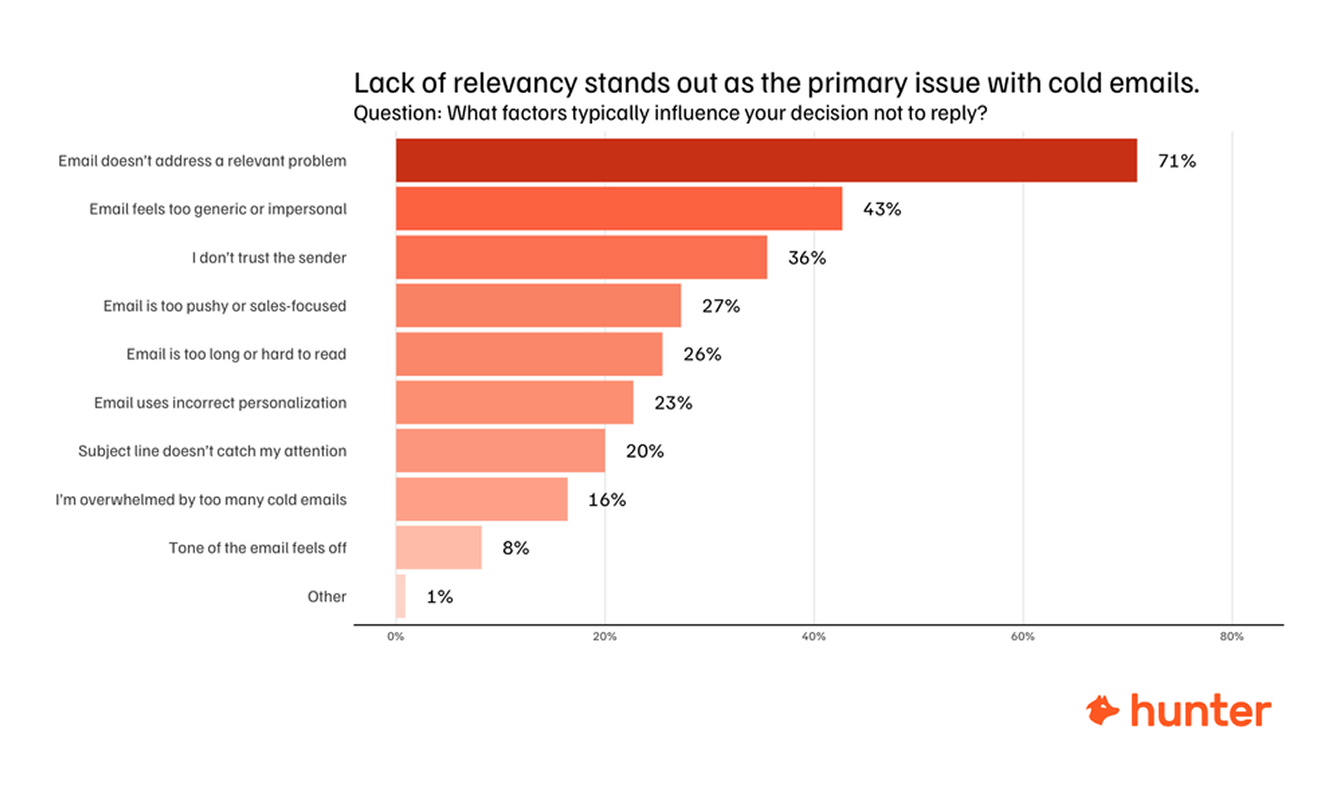
71% of decision-makers named lack of relevancy as the primary issue, followed by impersonality (43%) and lack of trust (36%).
What does this mean for you as you approach your cold emailing?
It's clear that decision-makers aren't done with cold email. They're done with spam.
Even clearer is the reality that too much cold email is indistinguishable from spam.
But for you, this is good news.
What makes cold email's successful?
Even though the average campaign reply rate is 4.1%, some campaigns are significantly more successful. Our analysis of 11 million cold emails sent in 2024 helped us pinpoint what influences success.
List building
Smaller campaigns perform better. Campaigns with 50 recipients or fewer get an average 5.8% reply rate, compared to 2.1% for campaigns with 1000+ recipients.
That's not magic; it's because segmenting recipients into smaller groups helps create more relevant copy that speaks directly to a decision-maker's needs.
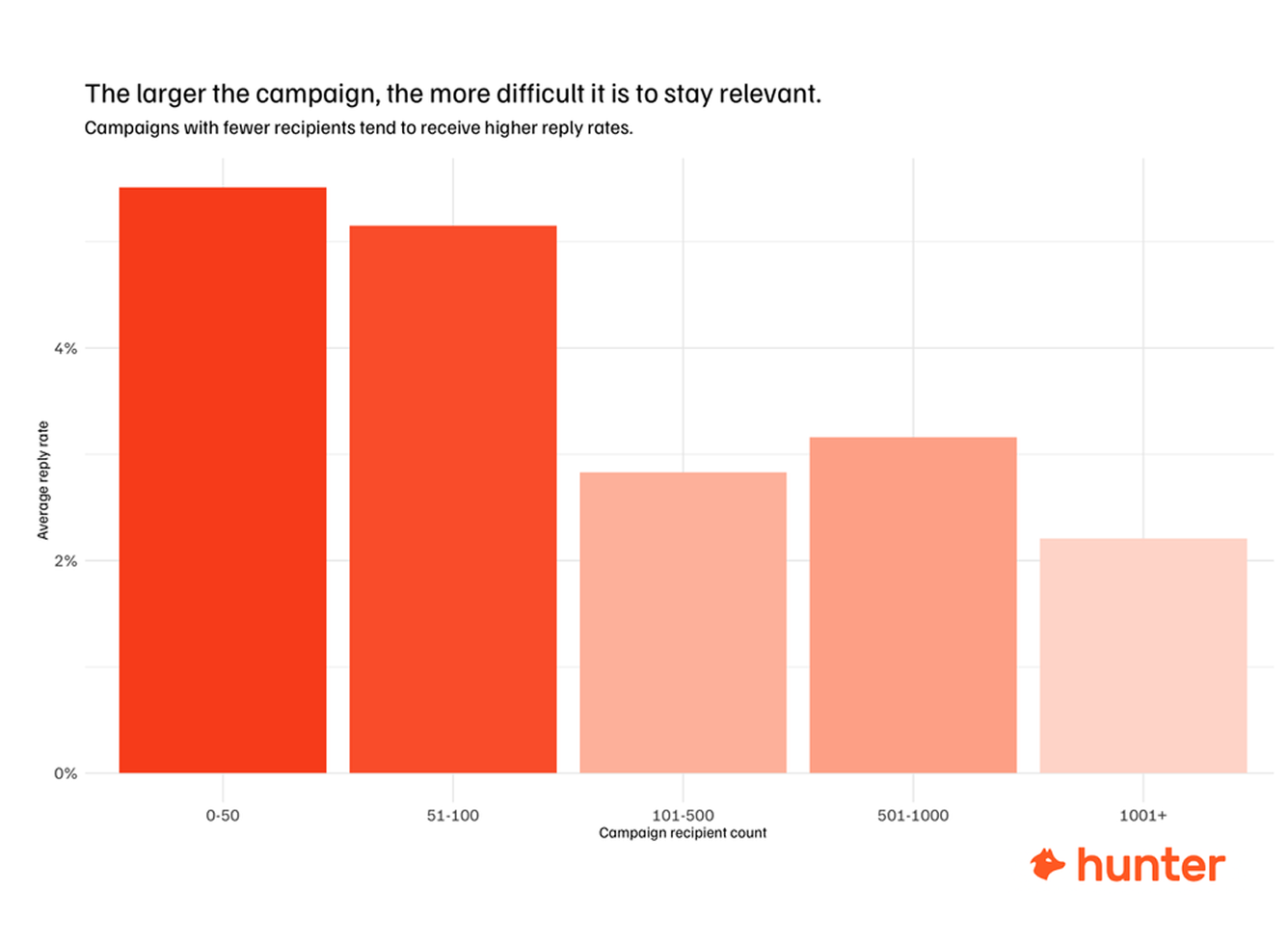
What does this mean for you as you approach your cold emailing?
Go too wide and your outreach will fall flat.
But sending campaigns with narrow targeting is easier said than done.
You need to intimately know your ideal customer profile, and you need a tool that makes it easy to create subsegments of your addressable market.
Luckily, Hunter can help with both.
Discover, our B2B database, makes it easy to find qualified prospects even when you're starting from scratch, and create narrow segments to tailor your message with pinpoint accuracy.
Personalization
Personalization is a great way to quickly prove to your recipient that you've researched them so you understand that your solution meets their needs.
Our survey shows that decision-makers truly value personalization.

There are two ways to make your cold email campaigns more personal.
1. Custom attributes
One is to use custom attributes (merge tags), which enables you to inject your prospects' data into your emails automatically.
These custom attributes can be as simple as company names and as complex as unique copy generated with AI for each recipient.
2. Manual edits
Another way is to manually edit the emails generated from a template–which is more time-consuming but gives you more control and space to be creative.
Both methods are associated with higher reply rates, and some campaigns achieve truly remarkable reply rates by using them together.
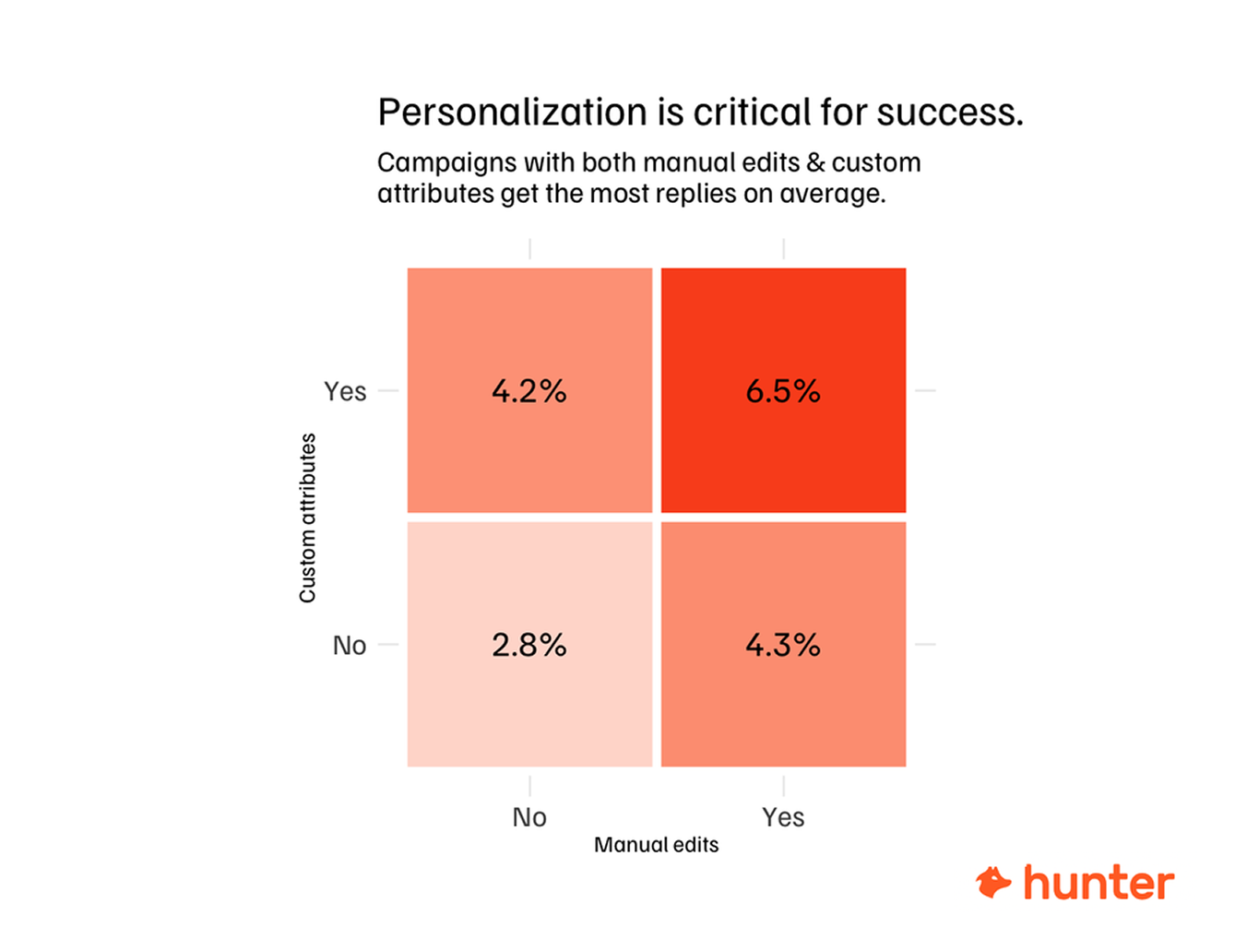
It's critical to note that both segmentation and personalization require accurate, deep data about your recipients. If you're looking for an enrichment solution to learn more about your leads, try Hunter's Enrichment API.
What does this mean for you as you approach your cold emailing?
Generic doesn't cut it. Cold email only works if it emulates the feeling and the relevance of a 1-to-1 message.
But it doesn't mean that it's not scalable. Using custom attributes and throwing in manual editing may seem like additional effort, but it pays off.
The role of AI
There's stigma around using AI to automate messaging.
We've all seen awful emails that consist of GPT mumbo jumbo and surface-level personalization.
However, most decision-makers don't care if AI is used to create the cold emails they receive.
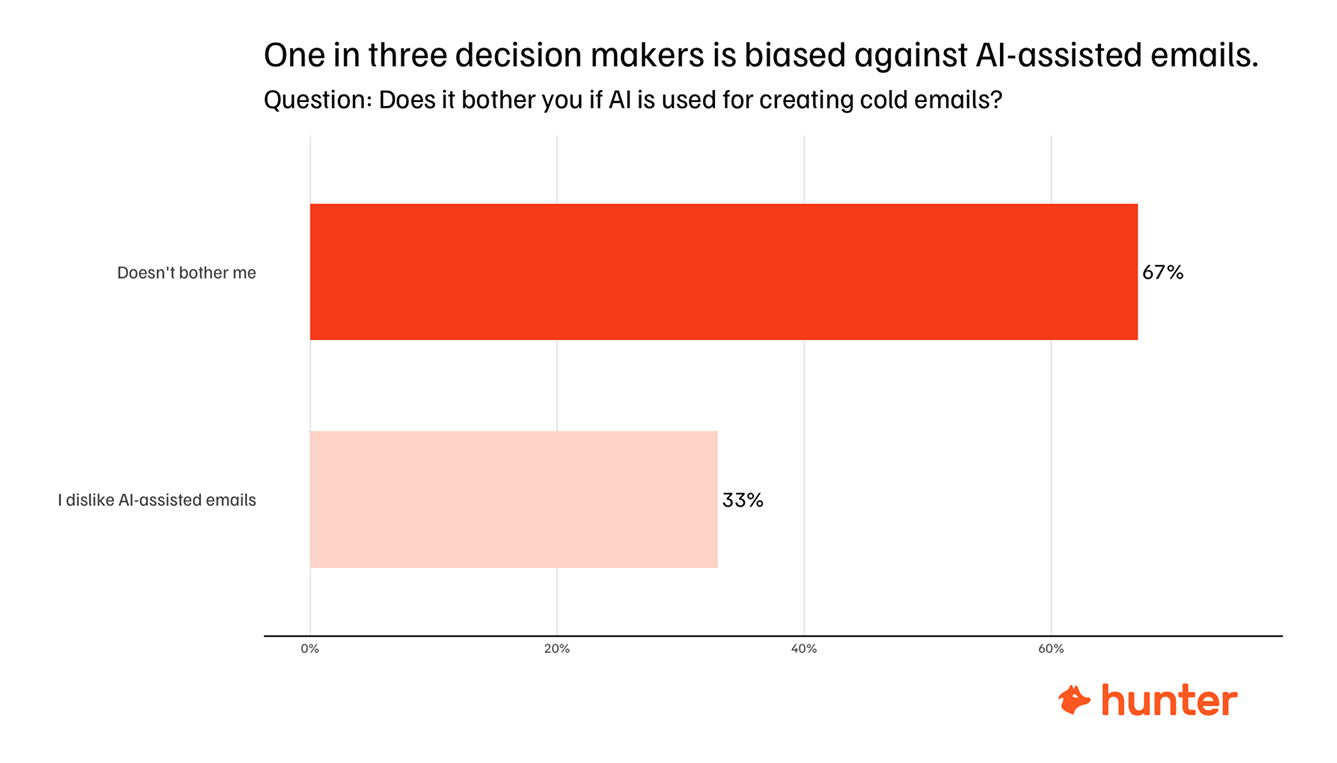
What does this mean for you as you approach your cold emailing?
It's not if, but how you use AI that matters.
If you deceive your recipients, many will quickly realize it and report spam as punishment. But nobody cares if you used AI as long as the outcome is a more relevant, thoughtful message.
Hunter's upcoming copywriting solution does exactly that: it takes your business case as input, and helps you connect it to the individual circumstances of your recipients.
Not to deceive, but to add a layer of insight to your message.
Sender domain
We've found that using webmail (free mailboxes like @gmail.com, @outlook.com, etc.) shows a negative association with reply rates.
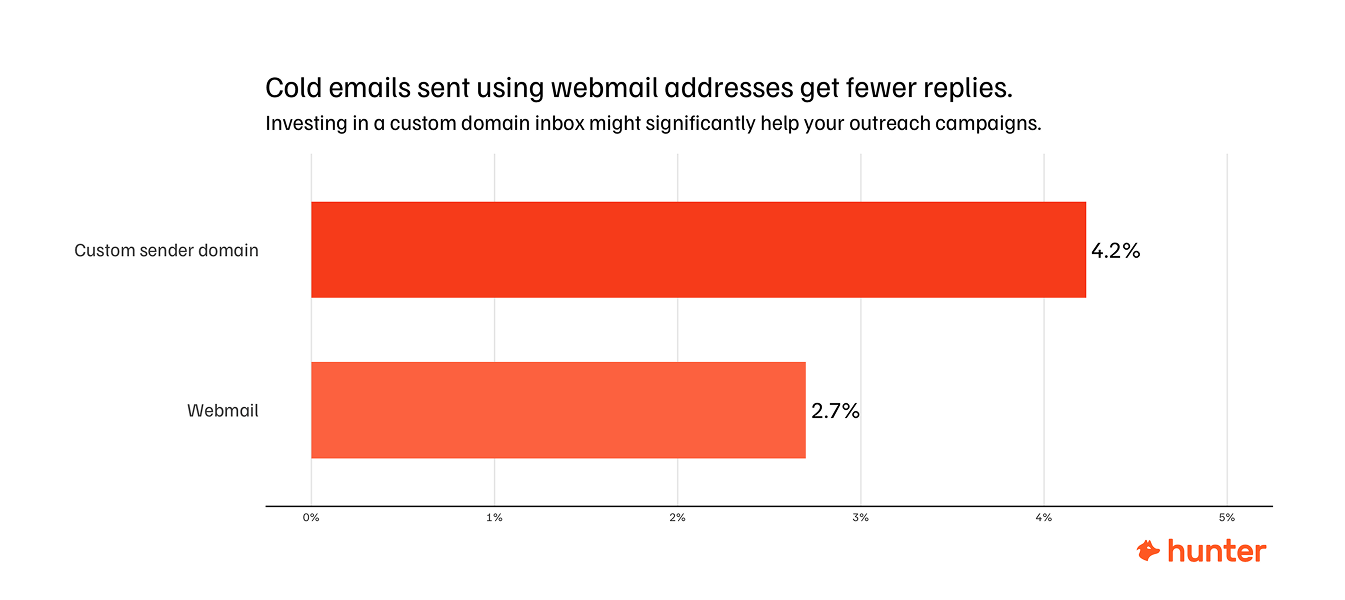
This corroborates our findings on the importance of trustworthiness, but it might also point to a different treatment of webmail senders by email service providers.
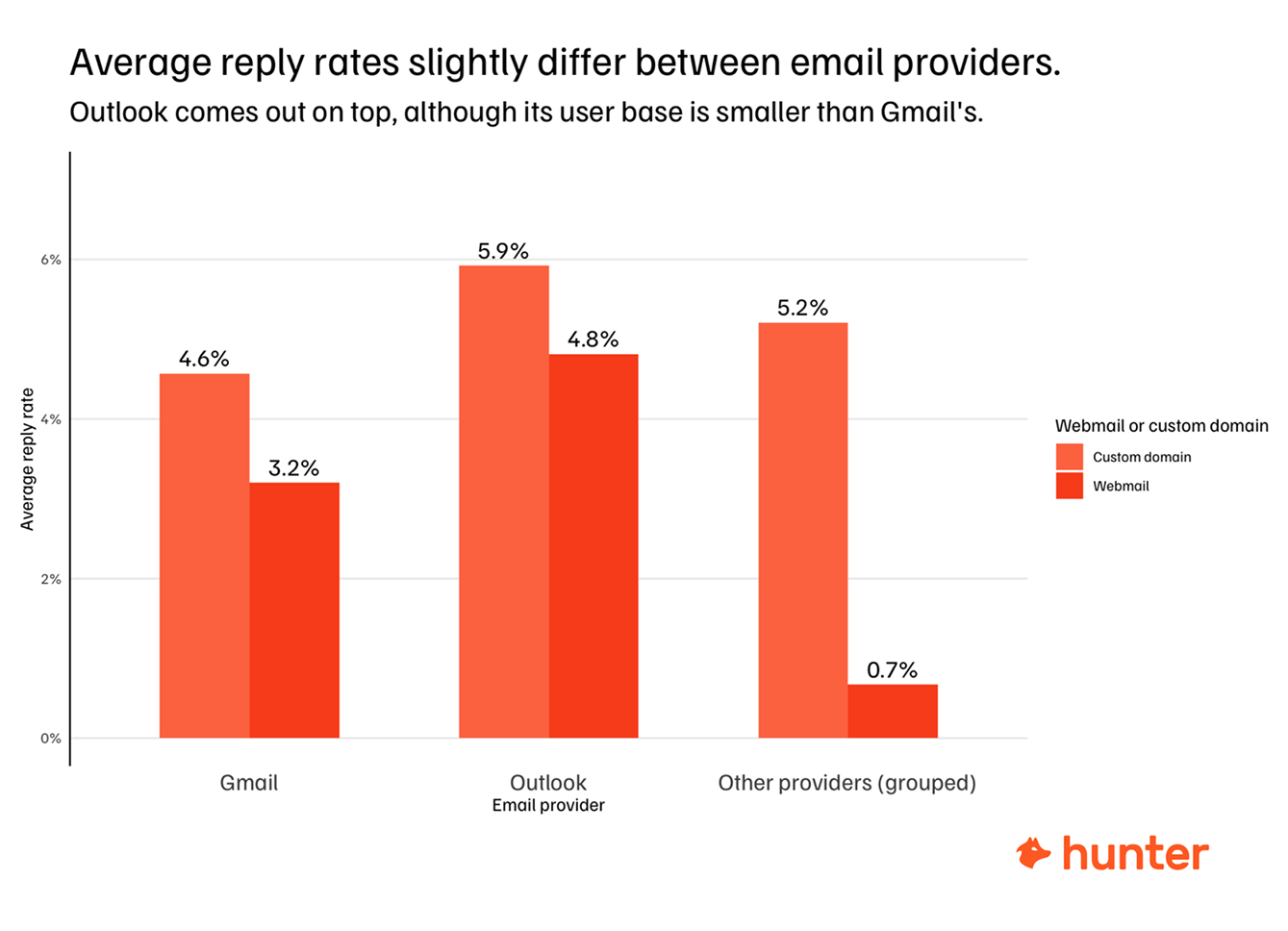
Over 80% of Hunter users use Gmail as the email service provider they connect to Hunter Sequences, with a smaller cohort of Outlook users, and a minority use other providers.
Using custom domains yields better results with any provider, but there are some differences in reply rates for custom domain users too.
Outlook with custom sender domain comes out on top with a 5.9% average reply rate.
The extremely low average value for webmail mailboxes with other providers must be taken with a grain of salt: we’ve only analyzed fewer than 100 email campaigns using this setup.
What does this mean for you as you approach your cold emailing?
If you're hoping to make cold email work for you long term, don't neglect the basics.
Getting the technical setup right can take as little as a couple of minutes, and will save you hours of headache.
Get a secondary domain with some custom inboxes, and don't opt in for the cheapest provider.
Tracking pixels
Similarly, we found that the average reply rate is lower for tracked campaigns.
Tracking pixels collect information about when your emails get opened, but anecdotal evidence has long pointed to their harmful effects on deliverability.
While our data indicates this, we're running experiments to test it further.
What does this mean for you as you approach your cold emailing?
Getting the technical set up of your cold emails right matters - but it isn't everything.
This is another reason to shift your focus on the role of cold email. It's here to drive replies and start a conversations. Don't fall into the trap of focusing on open rates as an indicator of success.
Efficient follow-ups
Campaigns with follow-ups have a higher average reply rate (4.9%) than campaigns without follow-ups (3%).
Our survey showed that most decision-makers either appreciate (48%!) or don't mind follow-ups (27%).
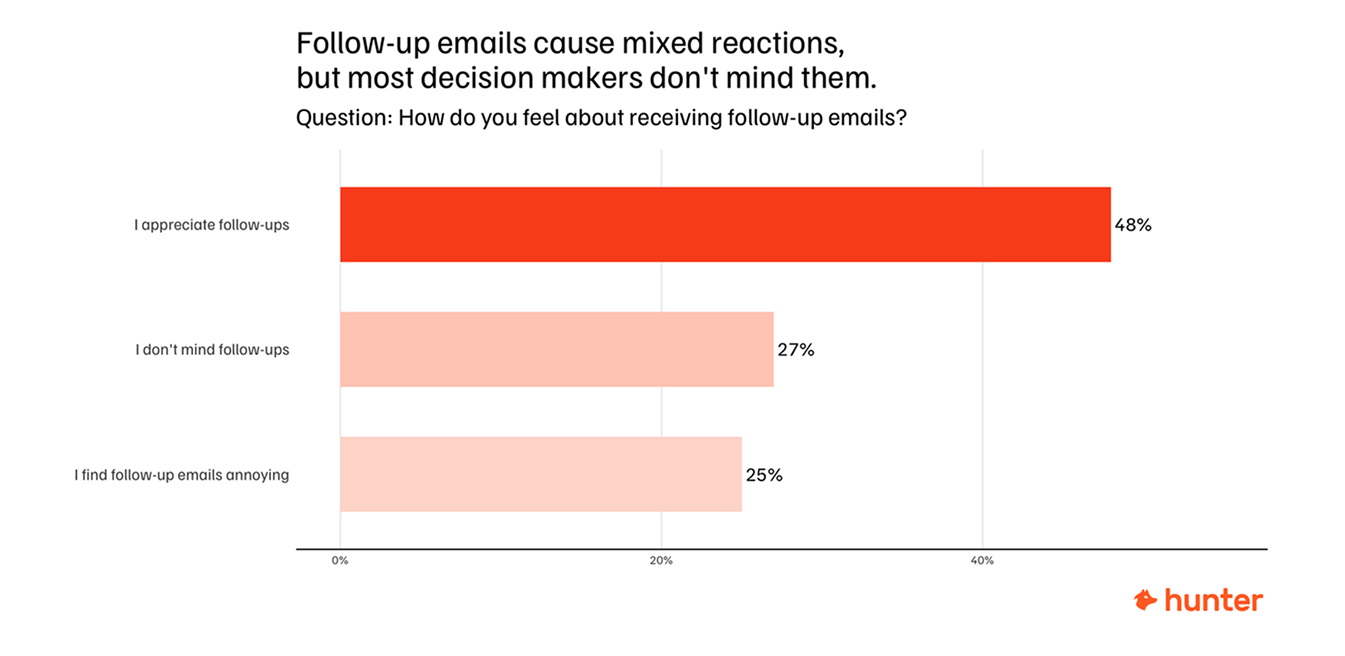
At the same time, 25% said they find follow-ups annoying, and excessive follow-ups were mentioned as one of the main reasons for spam complaints.
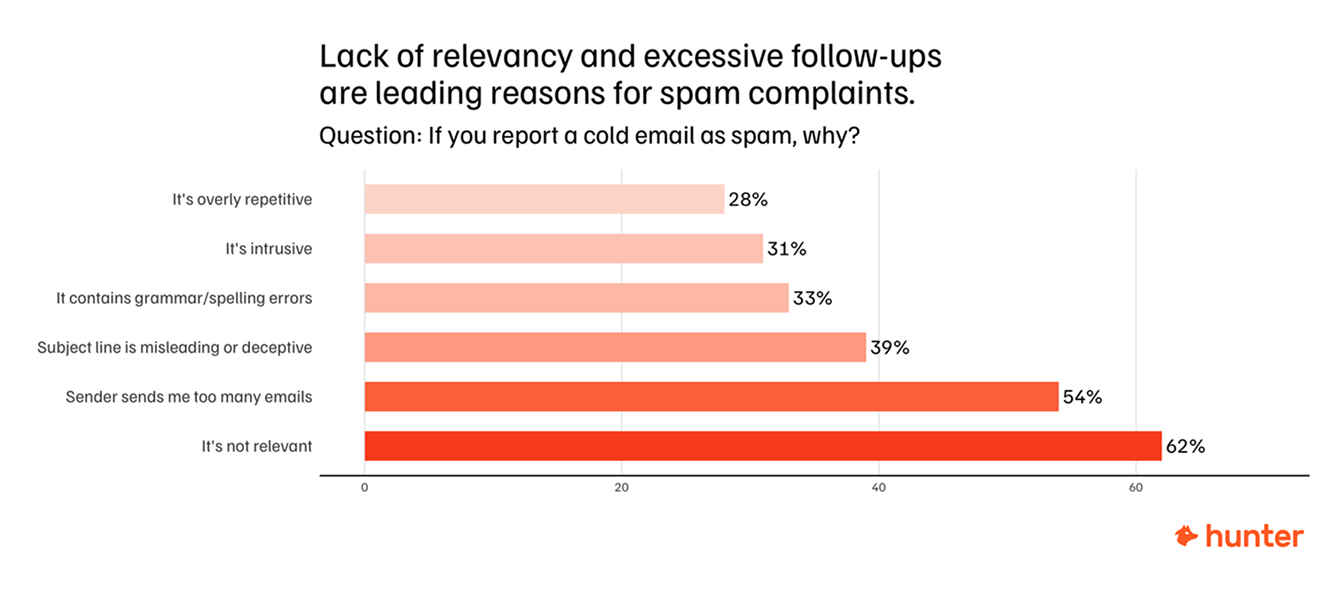
Hunter's users see higher reply rates when following up, but there's a point at which follow-ups become excessive and annoying.
After the third follow-up, unsubscribe rates grow, meaning spam complaints will likely go hand-in-hand with that.
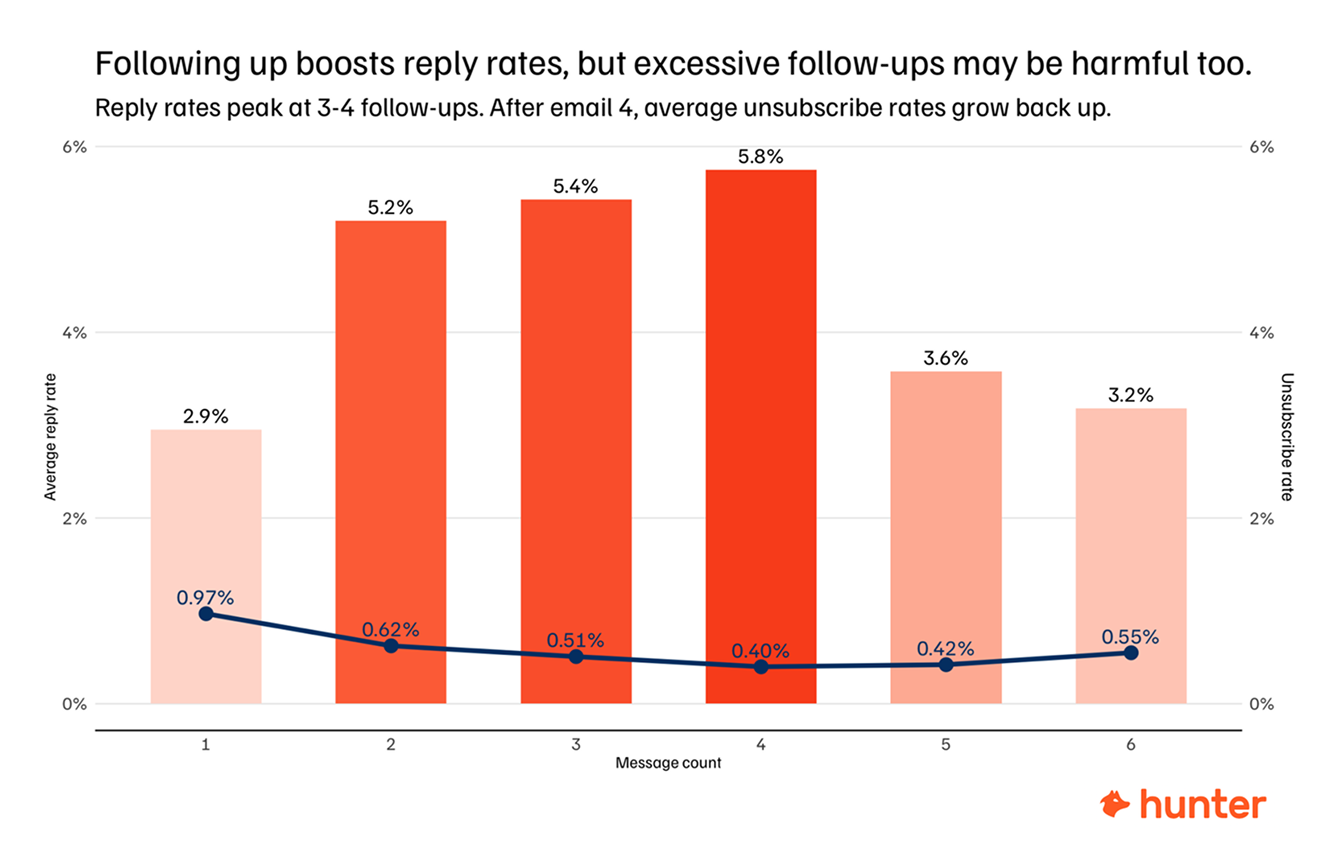
We've also used AI to analyze and classify follow-ups and find the most successful follow-up type.
Our analysis shows that referral requests are the most effective type.

What does this mean for you as you approach your cold emailing?
Decision-makers are happy to receive follow-ups as long as they are valuable, and the data clearly shows that following up brings more replies.
When planning out your sequences, remember that following up without adding value won't work.
Think of all the possible reasons why someone might ignore your email, and aim to address them in your consecutive messages instead of "just checking in" for the sake of it.
When to send emails
There is a common myth that there is a "right" time to email someone.
A lot has been said about this, but our research shows that it doesn't matter if it's a Monday at 3 PM, during a summer lull, or a rush towards Black Friday, decision-makers are indifferent to when you email.

What does this mean for you as you approach your cold emailing?
You might think that it's the Q1 that deserves 120% of your effort, but your leads don't think that.
Even if they don't have the same budget later in the year, they are still willing to evaluate your offer, and you shouldn't sleep on this opportunity.
Instead, make building connections and relationships your priority, looking for ways to re-engage leads throughout the year.
What doesn't seem to matter as much
Our analysis also looked at email word count and image count, which are often associated with cold email success. The findings here were surprising.
After crunching the numbers, we found little relationship between word count and reply rates: the correlation coefficient is -0.09.
Images are similar. Emails without images attached don't show a statistically significant difference in reply rates compared to campaigns without images.
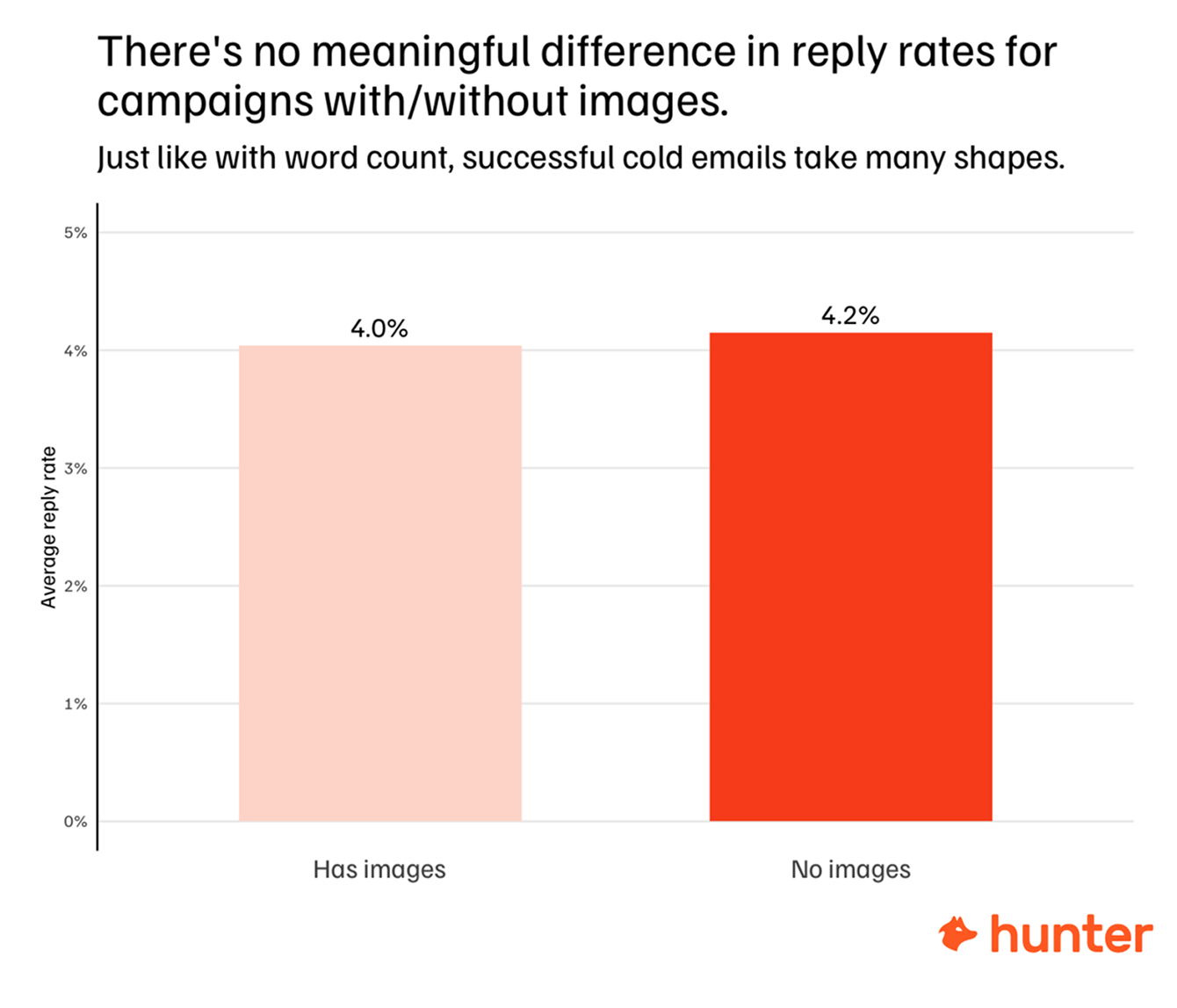
What does this mean for you as you approach your cold emailing?
Contrary to common beliefs, cold emails don't have to be extremely short, and they don't need to follow a single winning format.
Recipients don't count words and don't delete emails just because they contain an image or a link.
If you want to be like everyone else, send a plain text email between 40-60 words. Otherwise, it's time to get creative with your templates.
What is the future of cold email?
The state of cold email is the first step towards a new approach to outbound email.
For too long a "spray and pray" approach has been put to use for outreach. Decision-makers have voted with their fingers - specifically hitting "spam," "junk," and "trash."
Hunter's 2025 report shows you what decision-makers have long stayed quiet on.
As we move toward 2026, change must begin with each of us in the way that we approach cold emailing. With that mentality shift, we're then ready to embrace a new, better way to run campaigns.
To be part of that future, join our waitlist to get your hands on the difference-maker.
